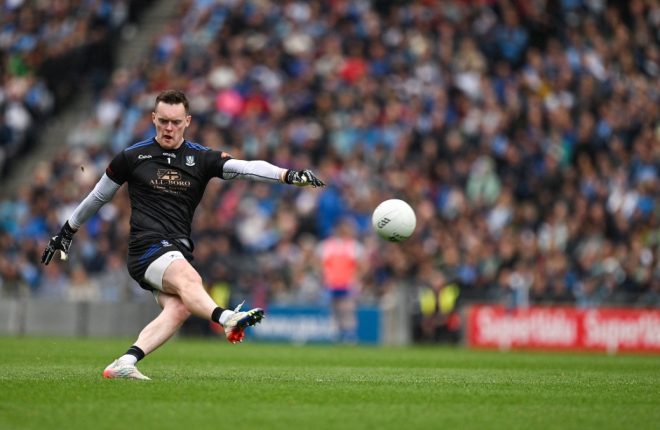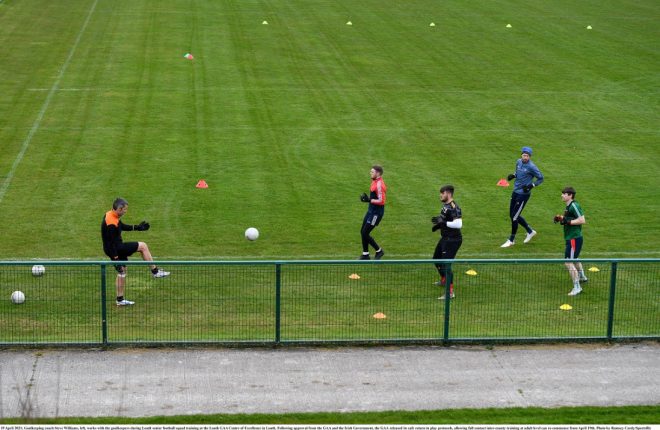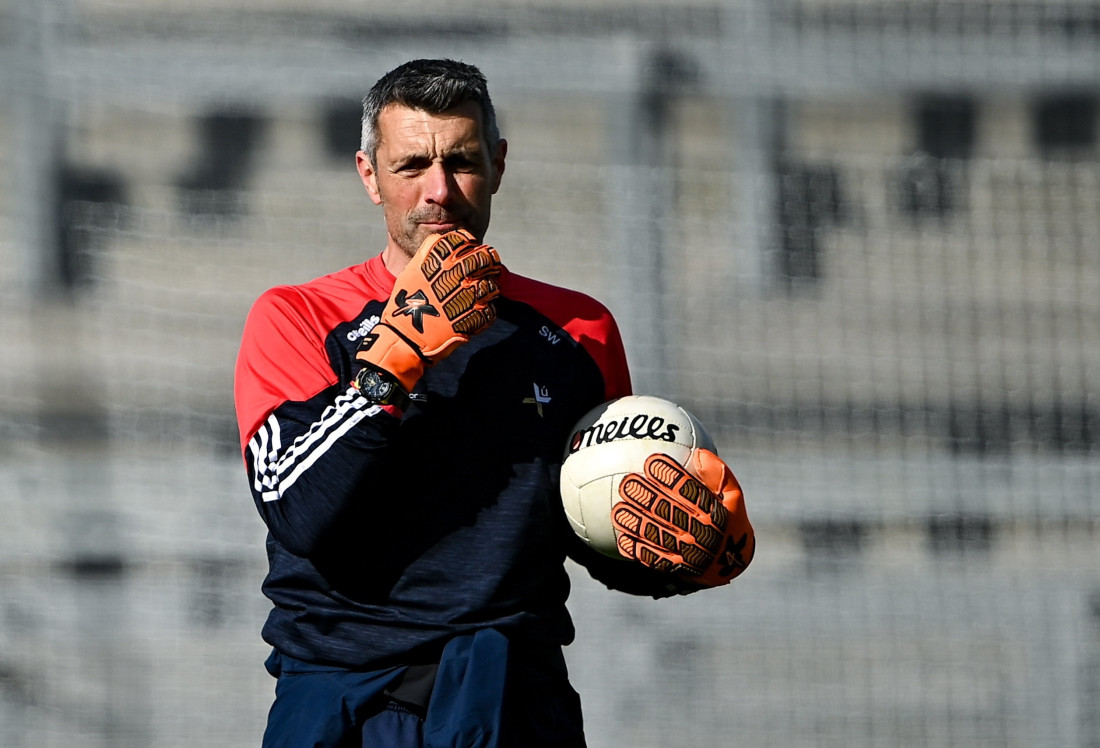Steve Williams is the man who discovered and harnessed the talent of Rory Beggan. The former soccer goalkeeper was also part of Glen’s All-Ireland success story. He chatted with Michael McMullan…
ABERYSTWYTH is not exactly a GAA stronghold. A native Welsh twang still hugs Steve Williams’ every word. But that’s as far as it goes.
Dundalk is now home since swapping Cardiff City for a temporary stint in the League of Ireland in 1997. Williams has been here since.
A Friday afternoon chat is insightful. He is on the road. It gives him time to arrange his thoughts. Goalkeeping comes in different shapes and sizes.
Louth’s opener with Armagh is on the horizon. His role with Shelbourne is packed into a schedule that demands time management.
There is a full-time job in the coffee industry. And with family, there has to be balance. Team environments are demanding. Meetings and coaching sessions. Analysis and homework. The weekend delivers a game or two. The odd random club session is thrown if there is a window.
It’s less than a week since Glen’s All-Ireland success and converted outfield player Connlan Bradley’s vital instinctive save from Ben O’Carroll.
The moment was hours, weeks, months and years in the making. The same can be said for Bradley breaking a St Brigid’s kick-out for a crucial play that was rounded off with Conor Glass’ thumping goal that changed Glen forever.
Williams shines a different light on the number one jersey. The making of Rory Beggan is no ordinary development story. Thumping out missiles was goalkeeping in a nutshell back in the day. Kick-outs were geared at putting opposition half-back lines under the pump.
Precision wasn’t a word on the radar. Sure, just let the soldiers on the battlefield fight their corner. Like goalkeepers of that era, tactics were as simplistic as varying the wing after a predefined number of lost kick-outs.
Williams would plot Beggan a different pathway on the way to Ulster glory and an All-Star for Beggan in 2018, the same season Dundalk completed the double with Williams also moulding ‘keeper Gary Rogers into Player of the Year.
The soccer background helped. From leaving home to join Coventry City as a teenager, Williams had a stint in Cardiff. It was then on to Dundalk before a successful spell with Shelbourne.
When Stephen Kenny was looking for a goalkeeper coach with Dundalk, it was Williams’ number he punched into his phone to begin a seven-year role.
Mickey Harte enlisted him with Louth and, after stepping away last year, he is back on board under Ger Brennan.
At the end of the Dundalk tenure, on the eve of taking on Rapid Vienna in the Europa League, Malachy O’Rourke’s number lit up on Williams’ phone. It was time for project Glen.
Before that, Eamonn McEneaney enlisted him to coach the Louth ‘keepers, in 2007, his first taste of GAA. When McEneaney took over his native Farney County at the start of the 2011 season, Williams was again called in.
For someone from mid-Wales, GAA wasn’t on the radar leaving home at 16 but living with a houseful of Irish lads in Coventry helped.
When Padraig McBennett retired, McEneaney was tasked for finding an understudy to Monaghan goalkeeper Mark Keogh.
The minors were training on one of the other pitches at the county’s training base in Cloghan when Williams saw the minor ‘keeper Beggan lamping kick-outs.
McEneaney offered Williams a blank canvas over the next two years to reshape Beggan’s game.
“I created a soccer-esque goalkeeper that could kick anywhere around the field,” he summed up.
“He could kick a ball a mile without actually knowing where it was going, that was the philosophy,” Williams recalls of the early days.
There was no sugar-coating it. Beggan was a rough diamond and would need an open mind. Williams was “quite hard” on his new protégé. He needed to be ahead of the first bumps in the road. Beggan would reach the top but a new outlook was vital. Being firm, Williams prodded as to why kick-outs were just lorried into midfield. With no direction, the chances of securing possession was 50-50 at best.
Williams floated the soccer theory that served him well. Overloads were explained. The value of runners was rolled out. Going short was an option and minding the ball became the new norm.

ROUGH DIAMOND…Rory Beggan was a minor ‘keeper when Steve Williams first laid eyes on him
It was about technique. Was there any real value in ballooning out the ball with nobody able to read its destination?
In his early teenage years, Williams had an advantage of getting the heads up of the new ruling on the backpass coming in to speed up soccer by preventing ‘keepers picking up a ball kicked back by a teammate.
He also remembers his agent Roger Watson’s advice. The ball needed addressed like a golf swing, to send it back via a straight path.
“You turn your body alignment to different angles and he taught me that two years before the back pass rule came in,” Williams explains.
The same message was passed on to Beggan. There was extra time after coaching sessions, kicking with the key elements assessed. Loft. Alignment. Trajectory.
Williams left the setup to join Kenny’s coaching team Dundalk the following season. His advice to Beggan was simple. The Farney number one jersey would be his if he worked at it.
“His desire to get to the top was evident and the rest is history,” Williams said. “He has been one of the best goalkeepers, along with Cluxton and a couple of the other goalkeepers in the country, for a long period of time.”
When Beggan trotted out to every restart, he resembled a golfer with a club for every eventuality. With very little run up, he could put the ball on a plate for a runner into any one of eight identified channels.
Eventually Beggan would bend new manager Malachy O’Rourke’s ear enough for him to bring Williams back on board full time in 2016.
Before that, Dundalk and Monaghan training nights clashed so Williams would take Beggan for the odd individual session.
Beggan would pull into a soccer pitch on an afternoon with a bag of balls in the boot. It was sporadic, yet enough to keep him fresh and mentally in tune.
“Malachy rang me the next year, 2016, to come and work with him because Rory was pestering him,” Williams says with a chuckle.
It was a more full on role with selector Owen Lennon also linking in as they worked on kick-out strategies.
A look at any game, and you’ll see the different kick-out routines. There will be bunch and break, with players clustered in the middle before darting into the pockets of space.
If an opponent scuppers this with a zonal approach, a player peeling to the sideline for a short might be the out ball. Michael Warnock was often Connlan Bradley’s option.
If a team presses right up, another option could be the long one over the top and flicked into the path of a runner. Just ask Jim Gavin of Paul Durcan’s long bomb flicked over midfield by Michael Murphy for Colm McFadden to score a vital goal in the 2014 All-Ireland semi-final.
No matter what way a plan is pencilled down, it will depend on player movement as much as the direction or weight of a kick.
“If players move and they move in the right manner, in different phases, then you will get the ball out,” Williams explains.
“He (Beggan) could put the ball down and hit any one of eight balls into any area of the field. If you left a gap on any one of those eight areas, he will find you.”
There will be very little run up. It’s all in the technique and, like the golf club, the kick depends on the precision of the point of contact.
A half step back can be added if there is a decision to lamp the ball 70 metres at the last second. That’s where the practice comes in and repetition. The point of impact dictates it all.
It also allows a kick to be executed through players standing 10 feet apart for the medium kick when the short and long doors are closed.
That’s the risky part. In that moment, precision and confidence are a kicker’s closest companions. And from testing it in challenge games, it boils down to both belief and muscle memory.
“He (Beggan) got a Monaghan team that were losing possession of the ball, his stats were going from 50 or 60 per cent up to the high eighties on a regular basis, which in Gaelic is very good,” Williams adds.
Another key benefit of technique is the efficiency of effort. Knees and ankles, at the optimum angle, will reduce the stress poor alignment will bring on the body.
Even approaching his 50th birthday, Williams himself can throw down a ball and ping it wherever it needs to go. It’s all in the technique.
With no muscle strains, it’s common for Beggan to hit between 80 and 110 kicks on any given night, even on Thursday of game week.
“Most goalkeepers can’t do that because they can’t kick it right and they hurt their hamstrings. They overstretch their leg after kicking which means the hamstring is under more stress,” Williams explains.
“Rory’s kicks were clean and tidy. His body became very robust to kicking and his legs were strong.”
Another dimension to Beggan’s game is what he offers going forward. He kicked points from play against both Kilcoo and Glen in Scotstown’s Ulster series. Only free-takers Jack McCarron and Shane Carey are ahead of him in their top scorers list.
There is the sight of Glen ‘keeper Connlan Bradley taking full advantage of a retreating Magherafelt defence to kick a point in the Derry final.

WEE COUNTY…Steve Williams is the current Louth goalkeeper coach
In Saturday’s pulsating league opener in Tralee, Odhrán Lynch and Shane Ryan were both on the overlap.
Williams accepts it now as part of the GAA scene as managers balance up the risk of a mistake leading to a goal, into an unguarded net, versus being the extra man to help stretch a packed defence at the other end.
Looking back at his soccer days, he was told the game was going to evolve too. Early in his career, goalkeepers stayed at home, in the six-yard box. Saving shots and dealing with corners was their only remit. Alarm bells would almost sound if a ‘keeper went outside the penalty box.
That preceded the high press coming into vogue, with ‘keepers beginning to play the ball out from the back. Gaelic football was the same. Possession is the key. Teams are increasingly using an unmarked player, now often the ‘keeper, for a pivot to recycle the ball from a packed wing to an open channel on the opposite flank.
At a more advanced level, it’s almost like a game of snooker where it’s the third or fourth pass that adds the real value. Thinking of the next pass is short-sighted.
“If you win the possession you have a very good chance of keeping it,” Williams said of the role a goalkeeper can now play.
“If I give a ball to a player who is overloaded by three players, it is my fault for giving the ball to him.
“There is the need to think about the next pass and the next pass. Then, I can join in on the next pass.”
While it can lead to a ‘keeper taking a score, that’s a bonus. The principle is arming yourself with an extra man when having to commit an extra body to push up on a sweeper at the other end.
Teams can then prod and keep prodding until an opponent switches off and there is a sliver of grass for a scoring chance. It is a game of patience, angles of run and squeaky clean use of the ball. It leaves some supporters tearing their hair out.
“There is the saying that with risk there is reward,” Williams admits. “If you gamble and it works, it pays off. If you don’t gamble, you’ll not break down the team.
“It might be once in a blue moon but you have to gamble. Playing sport, you can be lucky.”
He compares it to the frantic closing stages of a soccer game when managers would have unleashed their ‘keeper into the opposing box on a corner to chase a goal. Losing 1-0 or 2-0, what’s the difference?
“At the end of the day, it’s about winning the game and finding solutions to win the game,” Williams adds.
He agrees on the role of the goalkeeper coach being a different one. The evolution of sport dictates that.
Within that, every game throws up a different set of obstacles. It can range from the extent of an opposition press. The strength of the wind will be a consideration. The fog Glen had to contend with in their pressure cooker finale against Kilmacud Crokes.
“I have done it as a player at Shelbourne where you can play every style of a game but when the game happens, can you adapt all these different styles?” Williams offers.
“You have solutions but only use them when you need them in game, that’s the easiest way of doing it. You have to play the way that is going to win the game.”
Receive quality journalism wherever you are, on any device. Keep up to date from the comfort of your own home with a digital subscription.
Any time | Any place | Anywhere












